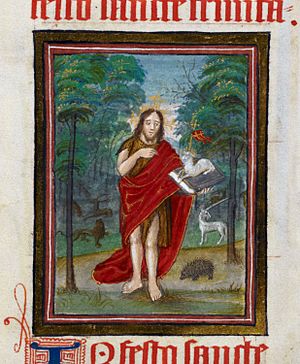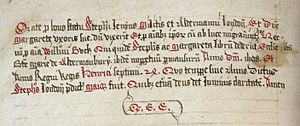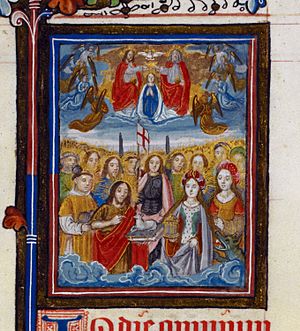Stephen Jenyns facts for kids
Sir Stephen Jenyns (born around 1450, died 1523) was a successful wool merchant from Wolverhampton. He was a member of the Merchants of the Staple, a group of merchants who controlled England's wool trade. He also became a Master Merchant Taylor, which was a powerful guild for tailors. Stephen Jenyns achieved a very important position when he became Lord Mayor of London in the year King Henry VIII was crowned.
He was also a generous supporter of art, architecture, and education. He founded the famous Wolverhampton Grammar School and played a big part in rebuilding the church of St. Andrew Undershaft in London.
Contents
Early Life and Business
Stephen Jenyns was born in Wolverhampton sometime before 1450. His father was William Jenyns, and his mother was Ellen Lane. When he was about 12 or 13, in 1462 or 1463, he moved to London to become an apprentice to a tailor.
He settled in London and became an important member of the Fraternity of Taylors and Linen Armourers of St. John the Baptist. This was a powerful group for tailors. He quickly became involved in important business deals.
Leading the Merchant Taylors
In the late 1400s, many guilds were making changes to how they were run. Stephen Jenyns became the Master of the Merchant Taylors' group. He made several important reforms. For example, he changed old rules about how Masters were chosen. He also stopped some payments and allowances that Masters used to receive. He even paid back nearly £22 himself to set an example.
After a former Master, John Swan, died, his widow, Dame Rose Swan, gave a large sum of money to the Company in 1493. This money was for a special service (called an Obit) for her husband. Stephen Jenyns was one of the people who helped manage her will when she died in 1497 or 1498.
Becoming Sheriff and Alderman
In 1498, Stephen Jenyns was chosen to be a Sheriff of London. This was a very important role in the city's government. The Merchant Taylors' group gave him special silver spoons and bowls to use during his time as Sheriff.
After being Sheriff, Jenyns became an Alderman for the Castle Baynard area of London in 1499. He held this position until 1505.
Family Life
Stephen Jenyns was married twice. His first wife, whose name is not fully known, had two daughters with him: Katherine and Elizabeth. Sadly, their mother passed away before 1502.
In 1501, Stephen Jenyns married Margaret Buck. She was the widow of William Buck, who had also been a Master of the Merchant Taylors. Margaret was a very supportive wife. She gave the Merchant Taylors' Hall three beautiful tapestries (large woven pictures) that showed scenes from the life of St. John the Baptist. These tapestries completed a set of nine that decorated the Hall. Margaret also gave a special blue velvet cloth for their Chapel.
Margaret's brother was John Kirton, a trusted lawyer. Through this marriage, Stephen Jenyns became a stepfather to Margaret's four sons and one daughter from her first marriage.
Mayor of London
In 1508, Stephen Jenyns became the Lord Mayor of London. This was a huge honor! He was the first Merchant Taylor to become Mayor. King Henry VII himself helped him get elected.
During his time as Mayor, his daughter Katherine married John Nechylls, who was also a Merchant Taylor. His other daughter, Elizabeth, married William Stalworth.
A Special Book for the Church
Sir Stephen and Dame Margaret Jenyns gave a beautiful book called a Lectionary to their church, St. Mary Aldermanbury. This book had 16 colorful pictures showing important religious holidays like Christmas and Easter. It also had pictures of St. Stephen and St. Margaret, who were the special saints for Stephen and Margaret. This book is now kept in the British Library.
After Stephen Jenyns became a knight in 1509, a special message was added to the book. It asked people to pray for Stephen and Margaret, and for William Buck. It also said that Stephen was Mayor of London in 1508.
Royal Events
As Mayor, Stephen Jenyns had important duties during a time of big changes in England. In May 1509, he and other city leaders attended the funeral of King Henry VII. They met the King's body at London Bridge and went with it to St Paul's and then to Westminster.
Soon after, King Henry VIII was crowned. On June 23, 1509, Stephen Jenyns and the Aldermen led the city's crafts and guilds in a grand procession for the new King. After the coronation, King Henry VIII made Stephen Jenyns a knight. This meant he was now called "Sir Stephen Jenyns."
Founding a School in Wolverhampton
Sir Stephen Jenyns never forgot his hometown of Wolverhampton. He wanted to do something special for the children there. In 1512, he got permission to set up a Grammar school in Wolverhampton. This school would teach boys "literature and good behaviour."
To support the school, he gave the Merchant Taylors' Company land that was worth £14 a year. This money would pay for a Master (head teacher) and an Usher (second teacher). The school was likely built around this time. This school, Wolverhampton Grammar School, is still open today!
Final Years and Legacy
Sir Stephen Jenyns's last big project was helping to rebuild the church of St. Andrew Undershaft in London. He paid for the entire north side of the main part of the church, including the roof. He also paid for the windows and pews on the south side. He died before the church was finished, but others helped complete it in 1532. This church is one of the few medieval churches in London that still stands today.
His Will and Burial
Sir Stephen Jenyns made his will in January 1522. He asked to be buried in the London Greyfriars church. He wanted 24 poor children to carry torches at his funeral. He also left money for many church services and gave generous gifts to charities. His will was officially approved in May 1523.
He also made sure that the Merchant Taylors' Company would continue to receive money to pay for special services in his memory.
His Tomb and Family
Sir Stephen Jenyns had a special tomb made for himself in the church. It was decorated with his family's coat of arms and the symbol of the Merchants of the Staple. His tomb had a detailed statue of him wearing armor and a long red robe, with his hands together in prayer. Sadly, this tomb was later destroyed.
Sir Stephen Jenyns's granddaughters, Joan Nechylls and Elizabeth Stalworth, were alive when he died. His family connections continued to be important. His apprentice and godson, Stephen Kirton, became a successful wool merchant, just like Sir Stephen.
The Wolverhampton Grammar School remained under the control of the Merchant Taylors' Company for many years and continues to be a successful school today. The church of St. Andrew Undershaft became the burial place for many of Sir Stephen Jenyns's family and friends, showing his lasting impact.




